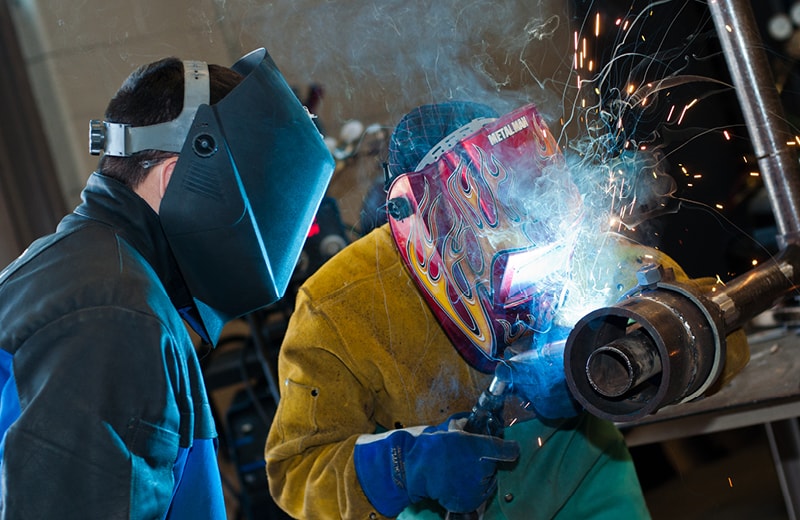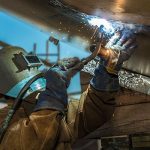The fundamental principle of arc welding is to connect a metal electrode to an electrical power supply, forming a closed circuit if the plate is touched with the electrode. When the electrode is raised from the plate by a few millimetres, the electric current jumps the gap and an electrical arc is created at high temperature. This results in melting the parent metal and the metal in the electrode, allowing both the metals to fuse.

Figure 1: Circuit diagram of arc welding process.
Arc shielding is an important aspect of all arc welding processes. In order to prevent oxidation the fused metal, the arc is shielded from the ambient air, and contact with oxygen and water vapour are cut off. The two mostly used shielding techniques used by shipyards are as follows:
· Slag Shielded Arc Welding
· Inert Gas Shielded Arc Welding
Slag Shielded Arc Welding:
Slag is the residue left over after the parent metals and the electrode metal has fused. It forms a layer over the arc and the welded joint, protecting it from oxidation. The presence of slag stabilises the arc, providing a better weld quality. There are three main Slag Shielded Arc Welding processes used in shipyards:
• Shielded Metal Arc Welding: The filler metal of most electrodes used in the shipbuilding industry is mild steel. Mild steel drawn in form of rods are coated with a mixture of mineral oxides, fluorides, silicates, hydrocarbons, and a liquefied binder which binds them together to form a solid envelope around the fuller metal. This coating forms the slag, stabilises the arc and prevents oxidation of the joint. Shielded metal arc welding is used in the fabrication of panels, grillages, tank units, etc. They are used in manual arc welding processes, and can help achieve welding at different positions, namely:
· Down hand welding.
· Overhead welding.
· Vertical welding.
Positional flexibility with this welding process makes it the only welding process used to weld the underside of overhead deck plates.
• Submerged Arc Welding: In this welding process, the arc is sparked and maintained under a blanket of granulated flux which is laid on the weld joint before the arc strikes the joint. Follow the figure to understand it further.

Figure 2: Submerged Arc Welding.
A hopper containing granulated flux runs along the length of the weld joint. It deposits a blanket of flux on the joint. The hopper is followed by a trolley which holds the filler metal electrode. The electrode is continuously fed by rollers driven by a drive motor, and the feed rate of the electrode is set to such a value so that the electrode tip is always submerged within the flux. The arc is hence generated within the layer of flux, allowing complete insulation from the environment.

Figure 3: Submerged arc welding with a hopper leading three arc nozzles.
The speed of movement of the trolley, the feed rate of electrode and amount of flux on the joint are very important parameters that are pre-decided depending on the thickness of the plates, the material of the parent metal, and quality of weld joint to be achieved.
Submerged arc welding is the most commonly used downhand welding method in the shipbuilding industry, owing to its arc stability and quality of joint. Since most of the joints are welded on one side, a backing strip made of ceramic material is placed under the joint, to prevent the flow of weld bead from the other side.



Comments are closed